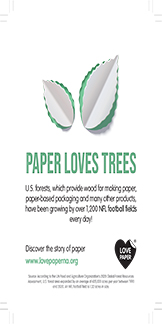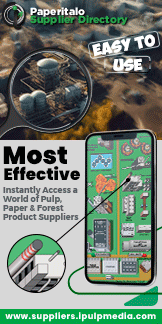In recent years, there has been a significant shift in the packaging industry. First in the UK and Europe, and now US and Canadian brands are moving towards paper-based packaging solutions. This transition reflects a growing corporate commitment to environmental sustainability, increased regulations and penalties for using plastic, and a desire to meet consumer demand for packaging that is both sustainable and easier to recycle, knowing it is not going into landfills.
All of these motivators drive a growing movement to support a more circular economy, which is one based on the reuse and regeneration of materials or products, especially as a means of sustainably continuing production.
Environmental Consciousness Drives Change
One of the primary reasons behind the shift towards paper-based packaging is a heightened awareness of environmental issues, particularly the impact of plastic pollution on the planet. While plastic packaging is convenient and versatile, it poses significant environmental challenges. Plastic is made from non-renewable petroleum-based materials - it is non-biodegradable, contributes to litter and marine pollution, is difficult to recycle and is harmful to humans and wildlife.
Paper-based packaging offers several environmental benefits, making it an attractive alternative to plastic. Unlike plastic, paper is renewable, biodegradable, and recyclable, making it a more sustainable option from a lifecycle perspective. Additionally, advancements in paper packaging technology have led to the development of innovative products that offer the same functionality and protection as traditional plastic packaging, further driving the adoption of paper-based materials.
Consumer Preferences Lead the Way
Consumer preferences play a crucial role in shaping the packaging choices made by brands. Surveys have consistently shown that most consumers prefer paper-based packaging over plastic for its perceived environmental benefits. This shift in consumer sentiment has prompted brands to reevaluate their packaging strategies and prioritize materials that are perceived as more eco-friendly. Additionally, market trends indicate a significant increase in demand for paper-based packaging, driven by concerns about plastic pollution and a desire for more sustainable alternatives.
A survey commissioned by Two Sides North America revealed that 55% of US consumers would buy more from brands and retailers who remove plastic from their packaging, up from 49% in 2021. Half said they are actively taking steps to increase their use of paper packaging, up from 41% over the past two years, and 47% said they would consider avoiding a retailer that is not actively trying to reduce their use of non-recyclable packaging, up from 39% in 2021. In addition, disposal decision fatigue is real-consumers preferred paper/cardboard packaging for being home-compostable (59%) and easier to recycle (43%).
Corporate sustainability goals driven by consumer demand are a primary motivator in the shift from plastic to paper. Wayne Towle, sales manager at fiber-packaging supplier Planet Paper Box Group, recently told Packaging Digest, "All the major players in all the major CPG companies have some form of sustainability goals factored into their business model. It is becoming more of a necessity for companies to do that."
Government Regulations Hasten Shift
Recent data from pulp and paper business intelligence company Fisher International cites several market factors driving the switch to paper packaging, including legislation in the U.S., Canada, and across the globe.
"Certain single-use plastics (e.g., drinking straws, coffee stirrers, plastic bottles, plates, cups, utensils, shopping bags) have been identified as leading contributors to plastic pollution and are the target of most legislation."
Twenty-three states in the US have some form of plastic bag legislation, and several cities have banned plastic straws. In Canada, the Single-Use Plastics Prohibition Regulations (SUPPR) were introduced as a larger comprehensive plan to achieve zero plastic waste by 2030 and reduce greenhouse gas emissions.
Big Brands Make the Switch
Several brands based or prominent in North America have embraced paper-based packaging as part of their commitment to sustainability and environmental stewardship. These include L'Oreal, Zappos, Pringles, Absolute, Apple, Nestle, Samsung, and Amazon. Although these are U.S.-based business giants, packaging innovation has often been initiated in Europe due to stricter penalties and regulations around plastic-based packaging. But North American roll-outs have picked up steam.
Iconic fast-food chain McDonald's announced plans to phase in more sustainable, recycled, and recyclable alternatives to their current packaging, including paper-based materials. According to the company, which serves 69 million people worldwide each year, McDonald's has set a goal of sourcing 100% of its primary guest packaging from renewable, recycled, or certified sources and expanding the reduction and recycling of guest packaging by the end of 2025.
An Amazon facility in Ohio uses machine learning to customize box sizes to eliminate plastic packaging fillers. The research was launched in Washington State's Amazon innovation center, and upgrades will roll out in North America this year. Technology like this could skyrocket the use of paper and cardboard packaging across industries.
Paper Fits the Bill
In so many ways, paper has become the ideal packaging material, offering businesses, manufacturers and consumers a simplified experience that cuts cost and time and is naturally sustainable.
Consumer preference. Consumers prefer goods packaged in materials that are easy to recycle or safe to compost. They don't want the inconvenience of stripping off labels or driving to a retail store to recycle plastic bags and clamshell containers.
Circular economy. Paper is a bedrock of a circular economy as it promotes the reuse and regeneration of packaging. Paper can be recycled five to seven times, on average, before fibers become unusable. Paper is biodegradable and compostable. In fact, clean cardboard adds valuable dry materials to the composting process.
Sustainable forestry. The US paper industry promotes sustainable forestry and depends on sustainable forest growth to provide a reliable wood fiber supply. By providing a dependable market for responsibly grown fiber, the paper industry encourages landowners to continue managing their forestland instead of selling it for development or other non-forest uses. In the United States, we grow more trees than we harvest, and US forests are a renewable natural resource and are not shrinking. Net forest area in the United States increased by approximately 18 million acres between 1990 and 2020 - an area equivalent to approximately 1,200 NFL football fields every day.
In Canada, all areas harvested on public land must be reforested through replanting or natural regeneration, and about 90% of Canada's forests are on public land. Canada leads the world in third-party sustainable forest certification.
Energy consumption. According to the American Forest and Paper Association (AF&PA), purchased energy is the third highest operating cost for the paper and wood products industry, motivating the industry to increase energy efficiency and use less energy overall. In 2020, AF&PA member pulp and paper mills self-generated 58% of the electricity needed to power their mills. They surpassed their collective goal for energy efficiency by reducing purchased energy by more than 13% between 2005 and 2020. Among the sustainability goals outlined in AF&PA's Better Practices, Better Planet 2030, one is reducing greenhouse gas emissions by 50%.
Similar efforts are being made in Canada to become more energy efficient. Most of the energy used at Canadian pulp and paper mills is generated using renewable, carbon-neutral biomass. Since the early 1990s, the Canadian forest sector has reduced its greenhouse gas emissions by nearly 70%.
Choosing Paper
The shift towards paper-based packaging among US and Canadian brands reflects consumers, governments, and corporations' broadening commitment to sustainability and environmental responsibility. By choosing paper, these brands are not only meeting consumer demand for more eco-friendly products but also contributing to the preservation of the planet for future generations.






















